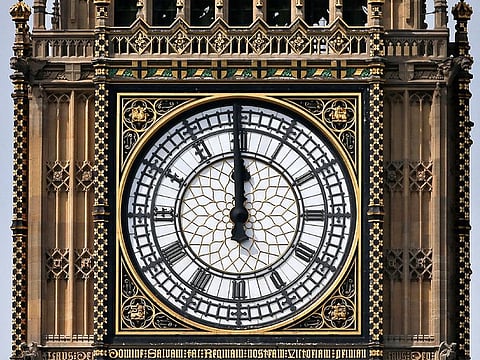Big Ben bongs again, five years and $95 million later
Since 2017, the Elizabeth Tower and clock face have been largely swaddled in scaffolding

London: The Great Bell of the Great Clock at the Palace of Westminster, known to all as "Big Ben," is scheduled to return to full-time service on Sunday, after being mostly silent for the past five years during the most ambitious renovation project ever undertaken at the crumbling Houses of Parliament.
At 11 am Friday, the Keeper of the Great Clock and his team of horologists tested the bells, and crowds gathered nearby at Whitehall to honor Armistice Day heard the old boy bong again. All went well.
"Marvelous, wonderful, been a long time," said Art Wallace, 56, visiting the capital city with his mother, down from Yorkshire in north England.
Since 2017, when the $95 million renovation project began, the Elizabeth Tower and clock face have been largely swaddled in scaffolding, and the 24/7 bells silenced - except to peal (with a replacement mechanism) on New Year's Eve, to mark Brexit and during the funeral of Queen Elizabeth II in September, when it rang 96 times, once every minute, for each year of the monarch's long life.
But now, Big Ben is coming back as part of the regular soundtrack of London life. It will announce the hour with the big bell and every quarter hour by chiming the notes G-sharp, F-sharp, E and B.
The BBC and other broadcasters carried the bells ringing live on Friday. It is a bit of good news for Britain, resetting its iconic clock, getting some normal back. It's been a head-spinning ride since the summer, with three prime ministers playing musical chairs - Boris Johnson out; Liz Truss in; Liz Truss out; Rishi Sunak in.
When the Victorian-era clockworks began to tick in 1859, it was the largest, most accurate four-sided striking timepiece in the world.
The sound of the deep gong has been used in a string of movies and television dramas and featured in a million video clips by visitors. The soaring Elizabeth Tower is one of the most recognizable architectural monuments in the world, up there with the Eiffel Tower and the pyramids of Giza.
This has been Big Ben's longest silence. In its 163 years, the bells (and the clock's hands) have been quieted or slowed just a handful of times - by heavy snow and freezing temperatures, and for brief repairs and maintenance.
Big Ben gonged throughout World War II, a symbol of defiance in the face of the bombing of London known as the Blitz, even if the lights of the clock dial were turned off at night so as not to help the German Luftwaffe find its targets.
The renovation of the tower and its gilded spire, the glass dials and stonework, the clock and bell mechanism in the belfry has been complex, and it was only after the conservation team erected the scaffolding that they saw how badly the repairs were needed.
The ironworks were rusty, the roof leaked. The stones were crumbling, a casualty of pollution and also the black paint used around the clock dials, which didn't allow the stonework to breathe. Cheap repairs done in the postwar 1950s made things worse.
The clock mechanism and strikers for the bells - the entire mechanism weighs 25,000 pounds - were removed and taken to the Cumbria Clock Company, clock specialists in England's Lake District, where more than 1,000 separate parts were cleaned and repaired, Parliament's media office reported.
During Remembrance Day weekend, a video of falling poppies - the flower that symbolizes the Britons lost to war - will be projected on the refurbished tower.
Lindsay Hoyle, speaker of the House of Commons, said in a statement that the illumination would be "a fitting end to a week of remembrance in Parliament in a particularly sad and poignant year."
Sign up for the Daily Briefing
Get the latest news and updates straight to your inbox



